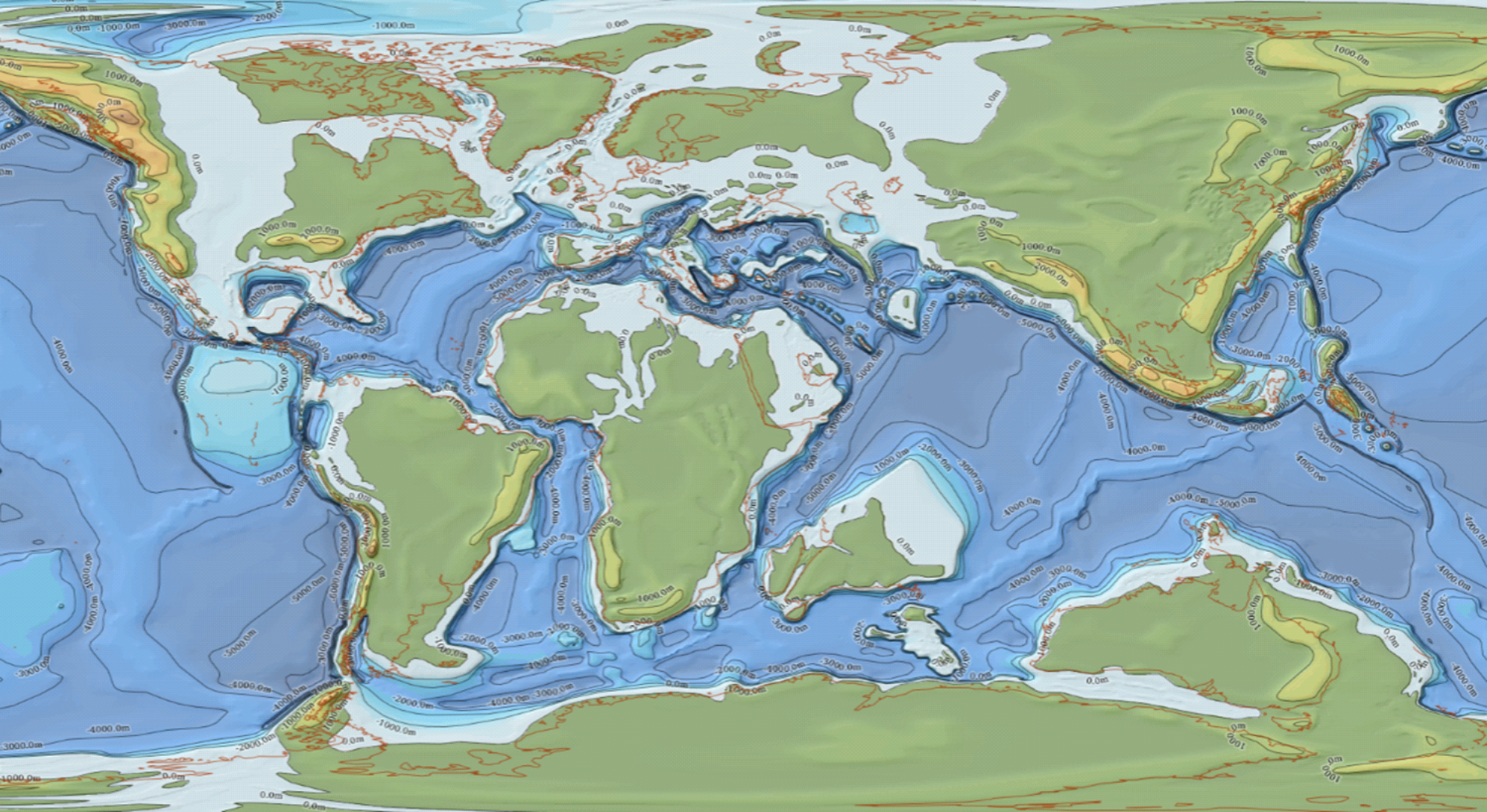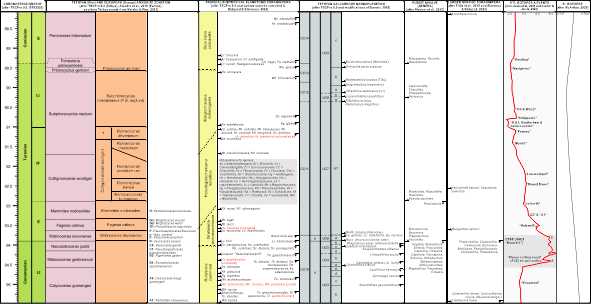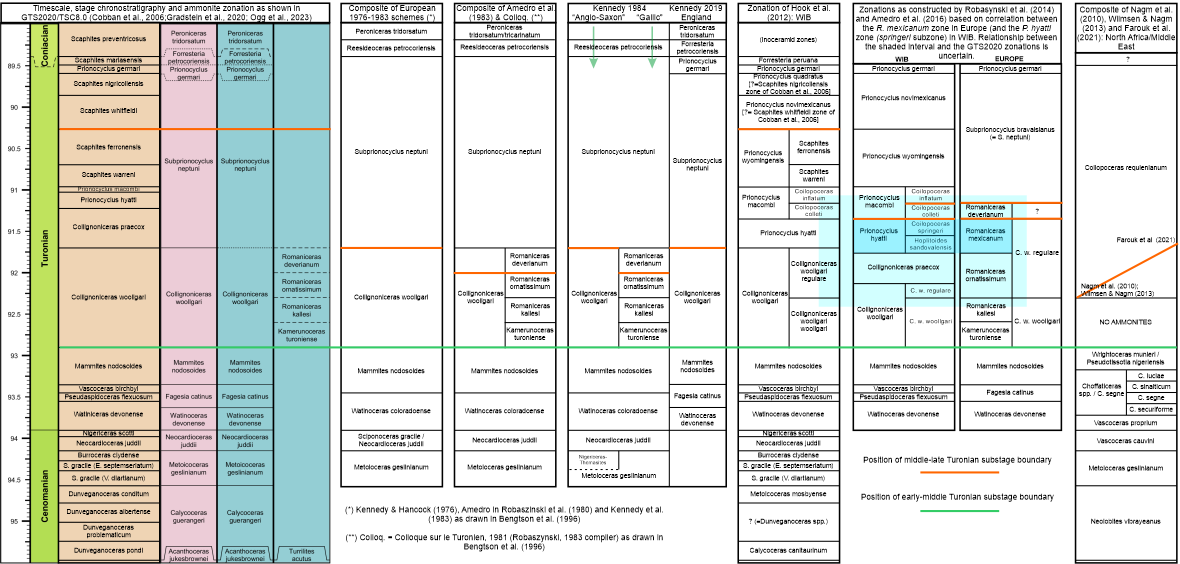A long-term research effort and goal is a better understanding of the Cenomanian stage of the Cretaceous period. The Cenomanian stage (93.9 - 100.5 mybp) is a particularly interesting time period which includes points when Earth's temperature and sea-levels were at their very highest. It is thought that sea-levels could have been as much as 200 metres higher than they are at the present day and annual mean surface temperatures 10-14 degrees higher than today. Two very significant oceanographic events occur at the beginning and the end of the Cenomanian that are also relatively rare in Earth's long history. These are called Oceanic Anoxic Events (OAEs) and represent significant periods of geological time where the worlds seas and oceans were significantly reduced in the amount of dissolved oxygen in the water. This, generally, was not favourable to life in the waters (although a few fossil groups seem to have thrived) and many marine organisms became extinct, or at least had their distribution considerably restricted.
Scroll down to the bottom of this page to see a table containing links to download our individual published papers.
 The position of the continents during Cenomanian times. High global temperatures have caused the melting of the polar ice-caps causing many areas of the continents to be flooded (light blue colour - note most of southern Europe, north Africa, the Arabian peninsula and the midwest of North America is flooded) and here, in tropical/subtropical zones, huge volumes of carbonate rocks (limestones) are deposited. The ocean between North Africa/India and Europe-Asia is called Neotethys. Previously a huge, wide ocean, it is currently (in Cenomanian times) shrinking due to the Atlantic Ocean opening and Africa rotating and (with India) moving northwards. Note that the present day Zagros Mountains (of southern and western Iran) is actually on the northeastern margin of the (Saudi) Arabian plate on the southern side of the ocean at this time but will "join" with its (Asian) Iranian counterpart just after the end of the Cenomanian. Closure of Neotethys along this junction will seal-off the (present-day) Mediterranean from the Indian Ocean, and precipitate large-scale stratigraphic re-organisation in the region. Image courtesy of the Halliburton Products Suite.
The position of the continents during Cenomanian times. High global temperatures have caused the melting of the polar ice-caps causing many areas of the continents to be flooded (light blue colour - note most of southern Europe, north Africa, the Arabian peninsula and the midwest of North America is flooded) and here, in tropical/subtropical zones, huge volumes of carbonate rocks (limestones) are deposited. The ocean between North Africa/India and Europe-Asia is called Neotethys. Previously a huge, wide ocean, it is currently (in Cenomanian times) shrinking due to the Atlantic Ocean opening and Africa rotating and (with India) moving northwards. Note that the present day Zagros Mountains (of southern and western Iran) is actually on the northeastern margin of the (Saudi) Arabian plate on the southern side of the ocean at this time but will "join" with its (Asian) Iranian counterpart just after the end of the Cenomanian. Closure of Neotethys along this junction will seal-off the (present-day) Mediterranean from the Indian Ocean, and precipitate large-scale stratigraphic re-organisation in the region. Image courtesy of the Halliburton Products Suite.
Since 2021, the research efforts of Mike Bidgood and Mike Simmons have been targeting the biostratigraphic calibration of Cenomanian rocks as, without more precise calibration, it is difficult to demonstrate the synchronicity of geological events in Neotethys and surrounding areas.
A recent study of ours (Simmons et al., 2024) looked at the major tectono-stratigraphic boundary that formed in the early Turonian, caused by the closure of Neotethys along the Zagros suture (see image above).This major sequence boundary, called the 'K150 SB' or the 'mid-Turonian Unconformity', was a major global event which caused a significant re-organisation of deposition in the central Neotethys area encompassing the Middle East region, and eroded the older Cenomanian strata down to various stratigraphic levels. Our re-calibration of 'standard' and 'local' biostratigraphic zones (including a major re-evaluation of ammonite biostratigraphy) and a comprehensive evaluation of the published biostratigraphy of individual sections, enabled us to demonstrate synchronicity of this event and to refine the timing of the event to the early part of the middle Turonian substage.


Biozonation calibration charts for the Turonian from Simmons et al. (2024). Left - multi-group synthesis, Right - ammonite zones. Click on image for a larger version.
Cenomanian Biostratigraphy
The above work on the early-middle Turonian was dependent upon a consistently-applied, well-calibrated biostratigraphic zonation. Such schemes are subject to constant revision and updates, based on the appearance of new data, particularly from regions which were historically under-studied. The Cenomanian stage is a good example of such a time interval, particularly for some fossil groups whose biostratigraphic potential has not been fully realised, or was in need of revision.
In 2022 (Bidgood & Simmons, 2022) we revised the biostratigraphy of Cenomanian planktonic foraminifera - a very important fossil group used in global biostratigraphy from the Jurassic to the present. In the same year we comprehensively revised the taxonomy and biostratigraphy of a single species of 'Larger' Benthic Foraminifera (LBF; Hemicyclammina whitei; Simmons & Bidgood, 2022). We expanded this study to include a small-ish subgroup of Cenomanian LBF (Simmons & Bidgood, 2023) and found that most taxa had either been incorrectly identified and/or incorrectly age-calibrated. We quickly realised the LBF group as a whole was in need of similar revision (the last review was published 40 years ago in 1985 with much new data published since then, including almost treble the number of species identified since 1985) and set-out a large-scale project which would tackle one sub-group (usually based around family or superfamily level) at a time.
Joining us for this major study are two world-renowned experts in Neotethyan LBF - Dr Lorenzo Consorti of the Institute for Marine Studies (CNR-ISMAR) in Trieste and Dr Felix Schlagintweit of Munich. Felix had already co-authored a paper with us on one specific genus of Cenomanian LBF (Bidgood et al., 2024).
Our first joint paper in what will be a 7-part series was published in 2024 (the Nezzazatoids) and the second (the Loftusiids) earlier this year (Simmons et al., 2024 & 2025). The third and fourth are expected to be published later in 2025 with the remainder following in 2026. It is hoped that after the publication of the final part, a single-volume work amalgamating all seven parts may be published.
Our published works are tabulated below and can be downloaded by clicking on the links. Work "in progress" is also shown and will be converted to downloadable links as soon as they are published.
